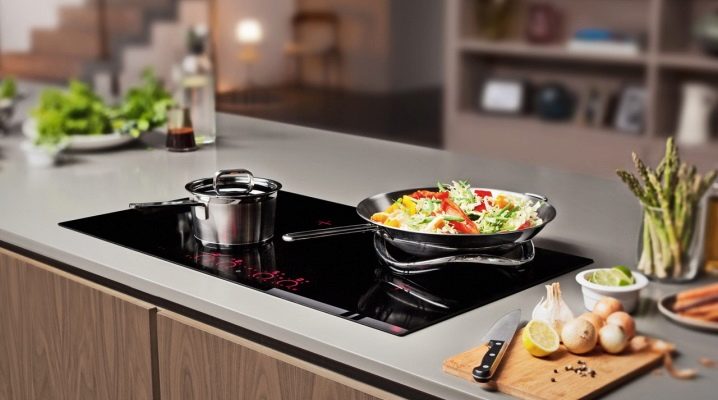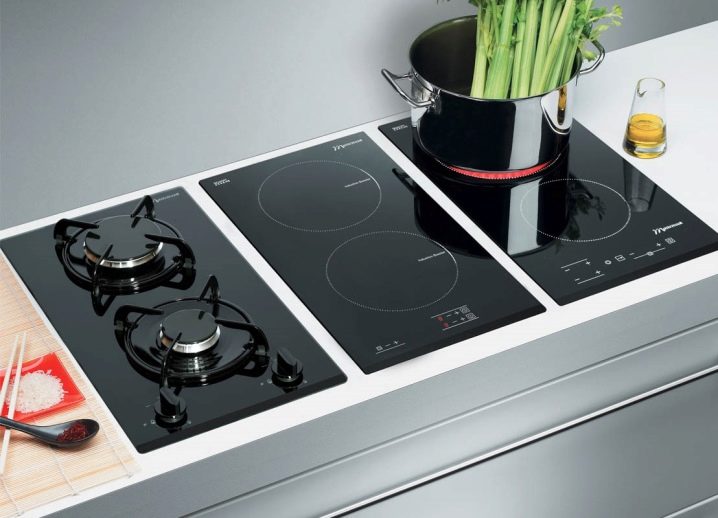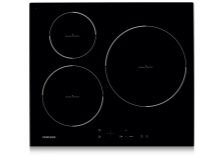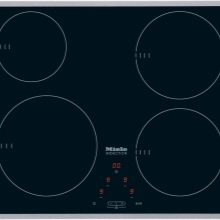Induction hobs: pros and cons, tips for choosing

The kitchens are full of all kinds of equipment. But even against this background, the innovative look of the slabs stands out. They deserve close attention and careful study.
What it is?
Induction hobs (hobs) began to be sold in Russia relatively recently. Few more slabs of this kind are being sold. Therefore, the majority of consumers have a rather vague idea of such products. But in fact, everything is very simple - there is nothing here that could not be understood from a normal high school physics course.
The cooking zones do not heat up. The principle of operation is that the dishes that are placed on the induction surface are heated. Or does not heat up - if this dish is not suitable. Heating is carried out by means of a magnetic field. An induction coil is hidden under the surface. It is this detail, with which the panel features are associated, that accounts for the bulk of the internal volume.

Strictly speaking, there are several coils - one per hotplate. Additionally, a temperature meter is used. With the help of it, the correspondence of the set power and the actual heating of the dishes is maintained. A special sensor must be covered with thermal paste.

Any modern design uses an insulating heat sink. This element allows you to guarantee the safety of other equipment in the vicinity. Otherwise, all metal objects within a certain radius will inevitably be heated by the same magnetic field. The control panel contains a microcontroller. This solution helps to control both heating power and auxiliary functions. Most modern induction hobs concentrate all the impulse only in the area where there is contact with the cookware.
In addition to eliminating the heating of foreign objects, this solution saves energy. Given the continuous growth of its price, this is only welcome. The latest modifications of induction cookers in terms of functionality are at least as good as gas and electric products, and in many cases surpass them.
You can cook any dishes on such stoves and panels, if only the design specifics and equipment allow.

Advantages and disadvantages
But a simple description of the basic properties is not enough to evaluate induction surfaces. It is necessary to pay attention to its advantages and disadvantages in comparison with the closest analogue - traditional electric stoves. In terms of current consumption, these options almost completely coincide. The highest electricity consumption reaches 6 kW. Moreover, even if the power is identical, the advantage of an induction hob is that food heats up faster.
Let the same pots of water be placed on two adjacent cooking surfaces. On an ordinary electric stove, they boil in an average of 15-20 minutes. But the use of induction coils can reduce this period to 5-7 minutes. The amount of energy consumed is approximately the same. Therefore, we can safely talk about the high efficiency of induction devices.

The very common idea that they do some kind of harm is not supported by anything. On the contrary, in terms of safety, such hobs are far superior to all other options.Above are the burners, which practically do not warm up during operation. Therefore, the risk of burns is very small. For comparison: the middle of electric burners heats up to 550 degrees, its edges - up to 150 degrees.
Similar indicators for induction models are 90 and 20 degrees. You can safely put your hand on the panel, accidentally touch it with another part of your body, with a towel, and so on - there is no risk. The lack of warm-up makes everyday care and cleaning easier. Even such a capricious product as milk will not burn. When cooking broth, the situation is the same.

An important feature of induction hobs is the smoothness and accuracy of temperature control. The meter does not get in the way of heat from heaters or hotplates, as is often the case with other types of kitchen equipment. The low temperature level allows for smooth melting of chocolate, butter and other foods. Attempts to solve the same problems with electric or gas stoves require them to be switched on and off continuously.
An additional advantage of the induction hob is the lack of air heating. Everyone knows how difficult it is to be in the kitchen when something is fried, boiled or baked for several hours in a row. With inductive cookers, preparing for the holidays is greatly facilitated.
The situation disappears when even the open windows do not allow you to get rid of the stuffiness. This property is especially valuable when it is already hot outside.

The logical continuation is that there will be no bad smells. Small dust particles, food residues, films of detergents and so on do not burn on induction hobs. Therefore, the smell of burning products characteristic of gas and electric stoves is excluded. Heating stops immediately when the pan is removed from the surface. This allows you to both increase the level of safety and save a lot of energy.
What is important, the automation accurately recognizes containers suitable for all parameters. Both their magnetic properties and geometry are precisely determined. An attempt to use unsuitable pots and pans will not lead to anything - the panel simply will not turn on. But we must also take into account the weaknesses of induction panels. They are invariably more expensive than classic electrical counterparts, because the technology is somewhat more complex.
Some models (in the inexpensive segment) are equipped with one magnetic field generator for every 2 burners. Therefore, it will not be possible to simultaneously use the entire stove at full capacity. Sometimes you can hear that induction circuits are unhealthy. But in fact, there is no real evidence of such a danger. The intensity of electromagnetic fields around modern people is already high, so giving up the newest types of hearth will do nothing.


How to choose?
Today the selection of induction hobs and surfaces is quite large. The most popular is the built-in product. But it must be borne in mind that the cost of such equipment is very high. By purchasing it together with the oven, you will have to pay more than for a separate appliance. These shortcomings, however, are fully compensated for by the excellent appearance and compatibility with any style.
An important point when choosing is to take into account the differences between independent and dependent surfaces. Independent devices can be delivered at any convenient location. It is not necessary to consider the requirements for the placement of the oven. The control of independent household appliances is completely autonomous. If a dependent device is installed, you will have to use the oven panel for control.
But they are ideally compatible with each other, both technically and aesthetically. The problem is, however, the inability to use the hob and oven if one or the other breaks. Only a professional repair will successfully solve this problem. When it comes to products with a frame, they are not very practical.
Outward beauty often results in the accumulation of dirt under the edge; however, at least there is no liquid flowing there.


Don't overly trust advertising claims about quiet hobs. Standard products are always noisy, but not too loud. But on the other hand, the very principle of operation of induction surfaces does not allow you to completely avoid the characteristic sound. It is also required to pay attention to geometry and design nuances. They are selected, taking into account the prevailing conditions in the room.
Built-in products always look more beautiful than full-size ones, but in any case, you will have to carefully measure the place for installation. For kitchens where there is an acute shortage of space, portable models are required.

Having decided on the size, they move on to assessing energy efficiency. For high-quality induction surfaces, it ranges from A to A +++. As for the number of work programs, it all depends on the cooking requirements. For those who are only going to have a delicious full lunch and dinner, the simplest version is enough. Its cost is minimal. However, gourmets and lovers of kitchen experiments will be more pleased with products that have 10 or more heat settings per burner.


The Booster option is of great benefit. This setting, present in almost any modern model, allows you to quickly heat something. It is used, for example, to boil a kettle. It is necessary to pay attention to the auxiliary functionality:
- timers for starting and shutting down;
- maintaining the same temperature;
- automatic boiling of heated water;
- defrosting cold food;
- creation of programs by users themselves and their storage in memory.
However, this does not mean that the best model is equipped with a maximum of buttons. It requires a thoughtful analysis of whether this or that option is really needed. Otherwise, you will have to overpay for overly powerful equipment. Another nuance is the network parameters (which are required for the normal operation of the hob). When everything is properly studied, you need to carefully read the reviews of the models you like, then the result will be optimal.


Number of burners
When all these parameters are determined, it is necessary to deal with the required number of burners. For a large family where lunches and dinners are regularly prepared, you will have to buy a hob with at least four burners. But for those living alone, when there is no prospect of change, you can limit yourself to a product with a pair of burners. It makes sense to buy single-burner models only for summer cottages and other specific cases.



And even there, a two-burner device is more practical. After all, it is often necessary, for example, to boil tea and cook soup. Doing this with a single burner will take a very long and inconvenient way. If there is not enough space for a two-burner panel, it is more correct to choose not a single-burner panel, but first take a closer look at the monolithic options. In terms of functionality, they are not inferior to products with 2 heating points, and they take up less space.

Portable hobs can save a lot. In most cases, 1 burner is provided (rarely 2). You can connect your portable device to any outlet as long as there is a level surface nearby.
Such a device is recommended for small-sized kitchens, for communal housing. In a number of places, however, another requirement is more relevant - reinsurance in case of power outages.

Such cases force you to choose not a clean, but a combined panel. Some hotplates are heated by a magnetic field, while others are heated by gas. Basically, models are sold where 1 or 2 of the four burners are powered by "blue fuel". It is a reliable system, however it is approximately 30-35% more expensive than a purely inductive heater. Some designers go further than others and, in pursuit of delights, completely abandon the burners.
The automatics are then set to recognize the place where the dishes are placed. This solution allows you to put 2 or more pots (pans) at the same time. And with the help of control elements, the heating power of each of the vessels is set separately. Whether it is convenient is up to every user to judge for himself. But the aesthetic merits are undeniable.

The form
Round, corner, as well as diamond, oval and even hexagonal burners are about the same in their characteristics. The difference between them is mainly limited by decorative properties. The size of the heating cells is more important. The geometry is selected according to the shape of the dishes to be heated. When the shape of the burners is selected, you can select the configuration of the surface as a whole:
- square;
- rectangle;
- hexagon.



Surface material
In order to save money and get the most out of it, it is useful to pay attention to enameled hobs. They look pretty nice and are quite heat resistant. However, there are advantages to glass ceramics as well. It differs in resistance to overheating and mechanical strength. First-class glass-ceramic products are used in slabs and panels from leading manufacturers.


Dimensions (edit)
The width of narrow slabs and panels is 30 cm. In a small-sized kitchen, such a product is best suited. But if there is more free space, you can choose designs with a width of 45 cm or more. For families with 3-4 people, models from 60 cm are recommended. The thickness is selected individually, but should not be excessively large, otherwise the device will be unreasonably heavy.



Rating
Consumers appreciate Electrolux hobs. The EHH 96340 XK model is especially popular. The built-in design is fully functional and equipped with a touch control system. An accelerated warm-up option is provided. The surface is equipped with 4 cooking zones.
Bosch PUE631BB1E can also give good results. This is also a four-burner electric model, which has a childproof lock and a residual heat detector. Control, like the previous hob, is carried out using sensor elements. However, it is still not very convenient. When any button is pressed, a loud sound is heard, which cannot be turned off in any way.


Importantly, quick clicks will get you nowhere. You will have to hold your finger on the button a little longer. The power of PUE631BB1E is not enough for strong heating of three sections at the same time. But 9 working modes will bring benefit. Any ferromagnetic cookware is compatible with the device.
Among the most budgetary inductive cookers, Lex EVI 320 BL stands out.... This design is equipped with highly sensitive touch switches. There are timer and temporary blocking functions. The device is assembled as carefully as possible. Selected components are used in its production; the designers also work neatly.

Among the two-burner devices, Kitfort KT-104 stands out... This surface works very well in small kitchens. Its cost is noticeably lower than that of devices of similar functionality. Management is very convenient and intuitive. However, due to the absence of a protective steel frame, there is a high probability of the dishes "leaving the stove" at the slightest carelessness.

Experts consider the Gorenje IT 332 CSC one of the best budget devices. The built-in hob works great even in small dwellings. Its positive feature in comparison with similar products is its increased productivity. The attractive black surface is durable. A timer and indicator are provided, but the most intensive mode of operation is poorly worked out by engineers.


Electrolux EHG 96341 FK - powerful induction hob for typical cookware... Temporary stop of work is done by pressing one button.The positive features of the product are somewhat overshadowed by an easily scratched coating.

Products from little-known and completely unknown companies should be chosen with great care. It is much more correct to focus on products of popular brands:
- Zanussi;
- Miele;
- Whirpool;
- Hansa;
- Samsung.



Operating rules
As with any other complex device, you must carefully read the instructions for use of the stove before starting work. All installation and connection of the induction hob must be done by a trained professional. It must be remembered that typical models today are supplied either without a plug or without a mains cable at all. To turn on the device and use it, you will need to buy all this additionally.
But if there is no knowledge in the field of electrical engineering, independent connection is impossible.

When the panel is unpacked and assembled, it is necessary to clean off all industrial contamination from it, including glue. For cleaning, use only those agents that are specified in the instruction manual. Usually it is a soft sponge without the slightest abrasive properties. The hob is started by pressing a special button for a few seconds. After the beep, you can select the desired hotplate and set other settings.
Important: cookers and hobs work correctly only with the normal choice of cookware. The minimum permissible bottom thickness is 2 mm. But it is better if it is 6 mm or more. It is allowed to use only those pans that are equipped with a monolithic anti-deformation disc. The minimum bottom diameter is from 12 cm; therefore, before using a small turk, you will have to buy a special adapter.


Induction heating of cookware with an uneven bottom is strictly prohibited. Therefore, the idea of using a cauldron and other exotic vessels without special supports will have to be abandoned. Before using any utensil, it should be properly inspected. Even if initially the bottom was completely flat, during operation it could become covered with cracks. All dishes that were previously placed on the gas stove are obviously unacceptable.

The use of containers without ferromagnetic material is not allowed. A special symbol or inscription helps to find out. It should be present both on the packaging and on the bottom of the dishes. If there is no designation, it is necessary to check the properties of the capacitance using a permanent magnet. But a pan made of non-ferrous metal and glass will not work; however, you can additionally buy an induction stand.

Trying to simply plug the induction surface into a free outlet is a bad idea. It is necessary to know in advance the cross-section of the wires in the corresponding section and their total bandwidth. Pay attention to the so-called load limit, set separately for each apartment or house. The safety measures are the same as for a conventional electric stove. So, do not put the kitchen appliance in an excessively humid place, and also pull out the plug from the outlet with force.
If the house has old aluminum wiring, it is best to replace it with a modern copper cable. And all the rooms at once, because it will be safer this way. The connection of inductive cookers through ungrounded sockets is absolutely not allowed.
And even if they are grounded, do not use extension cords or splitters. Attention is also paid to the technical condition of the socket; A wobbling or dropping out socket is unacceptable.


It so happens that the purchase and installation of the required power outlet is impossible. Then a terminal block is used, which is mounted in a back box. Both elements of the circuit are checked for resistance to the rated current of the device. Of course, you should remember both the phases and the grounding of the kitchen equipment itself. Installation and operation of induction hearths with ovens has no differences, except for increased power.

The operation of such equipment is prohibited if the wiring is not protected with an RCD. Both the rated and the differential breaking current are taken into account in order to select the correct "protector". Do not lay wires in places where they can be subjected to mechanical stress. The electrical circuit that serves the stove must not contain other devices. Built-in slabs and panels are first fixed in the furniture, and only then turned on. Test runs are prohibited.

Although induction hobs do not get clogged by contact with the boiled liquid, it is still undesirable. Regardless of the strength of the coatings, it is not recommended to subject them to point impacts (such as a corkscrew or knife falling down). If the plate is covered with glass ceramic, there should be no aluminum foil on it. It is very dangerous to start the hob without dishes or with empty pots and pans.

The dishes must be placed immediately, carefully and thoughtfully. Repositioning it can damage the coating. It is more correct to leave the automatic detection of the absence of dishes for critical cases, and not for normal practice. It is forbidden to use the hobs as worktops, shelves or in any other non-standard way.

Also not allowed:
- clean the hobs with steam cleaners;
- mount the hood lower than 65-75 cm;
- to operate a product covered with cracks.

How to care?
Not only the external attractiveness of the product and the comfort of the kitchen depend on care, but also the service life of the induction surface. A dish-washing sponge is not suitable, you need a special device. And they don't use it anymore. Strong blockages are removed with enamel or glass ceramic scrapers. Plain steel wool pads will not work.
Only silicone-based detergents are suitable. They form a reliable protective film. In some cases, liquid dishwashing detergents are used. But first you need to make sure that their composition does not contain components prohibited by the manufacturer. What absolutely should not be is the various powders and abrasives.

When the hob is washed, it is immediately wiped clean so that no traces of liquid remain. Ideally, it is advised to rinse the product as soon as cooking is over. Even if there is no externally visible contamination, it is very useful.
Experts advise to exclude clogging of hobs with sugar and salt. If they are accidentally scattered, this dirt is immediately brushed off or removed, and then everything is thoroughly wiped off.

All about the induction hob, see the video below.













The comment was sent successfully.